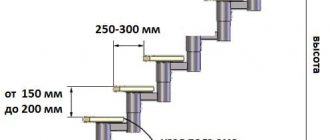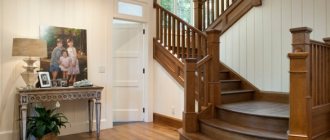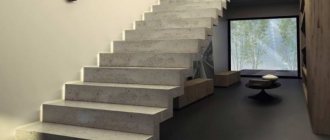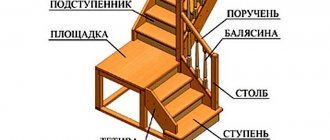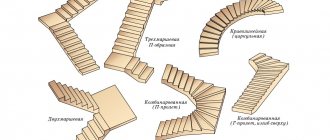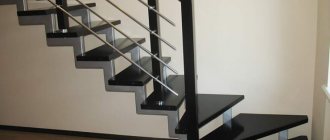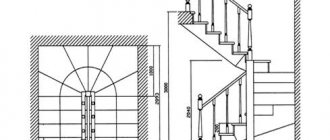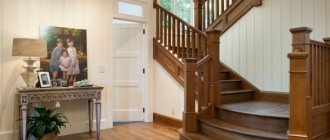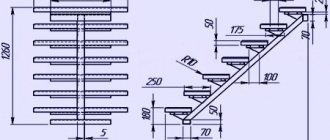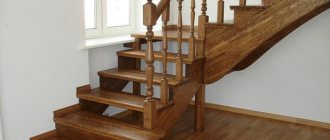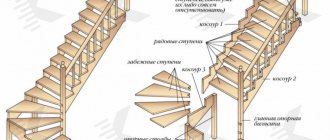Size of stairs steps according to GOST
The standards take into account all the nuances of the construction and use of transitional structures of the following types:
- interfloor;
- basement;
- attic
- evacuation.
Interfloor home stairs can be of the following types:
- straight;
- rotary;
- screw;
- outsiders.
According to the joint venture “Single-Apartment Residential Houses,” the slope, width and height of steps of stairs in private houses should “ensure convenience and safety of movement,” “the width and slope of stairs are not regulated.”
As you can see, there is no direct indication of the size of the steps. That is, in fact, these parameters are not strictly standardized. However, there are generally accepted rules based on experience: the standard height of a stair step should be in the range of 15–25 cm, and the depth – 25–30 cm.
For attic, folding, and basement options, it is allowed to exceed the standards of standard options. These models are rarely used, their installation space is often limited, so the height of the steps can be higher and the width narrower. Designs for such purposes are often non-standard. When installing a march in the attic or basement, take into account that it should be convenient not only to go up, but also to go down.
What you need to pay attention to when designing a staircase
All design work must be performed only by qualified specialists who are familiar with all the requirements of GOST and SNiP. The designer must take into account the wishes of the customer. The main criteria in choosing the shape of the structure, the number of steps and material for manufacturing will be the type of movement, the expected maximum load on the structure, and possible design solutions. In addition, it is important to provide:
- The maximum amount of space that can be used for the staircase must be taken into account; the shape of the structure and the supports for it will depend on this;
- if you plan to install stairs in an already constructed building, then there will not be many options for stairs. The best option is the simultaneous construction of the stairs and the building;
- The design bureau must consider all issues related to safe movement on stairs. The optimal height of the steps is selected. In rare cases, specialists deviate from generally accepted norms. As practice shows, most often injuries occur in stairwells where there are non-standard size steps;
- The issue of designing handrails and railings must be considered in detail, taking into account the maximum weight that can fall on them. The standard criteria are 100 kilograms. This allows the average person to lean his elbows or lean against the handrail and not break the entire structure;
- the staircase opening must have a gap of 2 meters between the ceiling and the stairs;
- Not the last factor in designing a staircase is the material from which the steps are made. If they slip in winter, you will have to lay carpet to avoid falling.
Requirements for the size of steps of evacuation stairs
There are fire escape stairs in every building, including individual residential buildings. There are special requirements for this type of structure.
During evacuation marches the installation of:
- screw and winder options;
- different sizes of stair steps;
- curved structures;
- wooden elements.
Requirements for escape stairs are specified in the joint venture “Fire protection systems. Evacuation routes and exits”:
- the depth of the steps of a straight staircase is at least 25 cm;
- the depth of the steps of the spiral staircase is at least 18 cm in the middle;
- riser height – no more than 22 cm;
- permissible slope – no more than 45°;
- number of steps in one flight – from 3 to 18 pcs.
We recommend that in all private houses, when constructing main staircases, be sure to be guided by the above requirements for the size and number of steps.
From the point of view of current standards in individual residential buildings, such restrictions are excessive. But in fact, they are the ones who guarantee you the convenience and safety of using the stairs.
Main varieties
There are two types of such structures in private two- and three-story houses: screw and marching. The latter type of stairs has a solid appearance and is considered more convenient to use. At the same time, screw structures take up less space in the building. They are usually installed in rooms that are not too large in area.
In any case, the main element of any staircase is the steps. When designing this part of the lifting structure, special attention is usually paid.
Ergonomic size of stair steps
The most important element of transitional structures are steps. When calculating the ergonomics of the stairs to the second floor, take into account:
- pitch of steps and slope of the march;
- tread depth;
- riser height;
- tilt angle.
Step pitch and slope of stairs
The step length is calculated based on the standard step length of a person - 60-64 cm. The size of the stair step (LS) is equal to the sum of the depth of the step (DS) and the height of two risers (VP). The total amount for a convenient design should be between 60-64 cm.
Universal formula for convenience: LS = GS + 2VP = 60-64 cm.
The slope of the staircase is calculated as the ratio of the height of the span to its length. For a normal model it should be in proportion 1:2, respectively. Classic ergonomic dimensions – 15x30 cm.
Moving along such a structure, a person will not experience discomfort and will not lose his usual step. The standard angle of inclination does not force you to strain and raise your foot high.
Tread depth
The depth of the step should ensure a comfortable position of the foot on the surface, not be too small so that the foot does not hang down and not be too large so that the sole does not “sink” on the step. This parameter is included in the overall dimensions and affects the length and height of the structure.
The optimal choice is considered to be a width of 25-30 cm. This is the average size of a person’s foot. To save material and make movement more comfortable, the gap between the treads is left open. This move allows you to comfortably place your foot on the step without fear that it will hang or slide.
Riser height
The permissible size of the riser is within 15-25 cm. This distance between the steps guarantees convenient and safe movement along the flight. Even if open space between treads is planned, the height between them must comply with existing standards.
The riser height should be the same for the entire staircase.
Descent and ascent should be comfortable and safe. Small size will result in a shuffling gait. High altitude will make movement difficult. When calculating the riser height, the step formula is taken into account. If the standard is not met, the design will become uncomfortable.
Span width
The optimal span width is considered to be 90-120 cm, the minimum is 80 cm. The ascent and descent along the flight should be comfortable and provide free passage for 2 people. If it is planned to lift large loads to the second floor, then the width is planned to be larger.
Comfortable width of stairs - these values are slightly larger than the minimum
In goose step models, you can set a smaller width due to the fact that the steps are uneven in size. This option is often used for attics and basements. Less commonly installed as an interfloor lift.
“Goose step” type design
The distance between the treads is large, but during installation they are installed in a checkerboard pattern so that a person alternately steps on the left and right steps. This allows you to maintain comfortable movement and makes the march narrow.
Spiral staircase parameters
Due to their compactness, screw interfloor options are popular in cottages with a small area. They save space. But when installing such models, they take into account the age of those living in the house. It is difficult for children and elderly people to move on such marches.
For spiral models, the angle of inclination is not taken into account. But even such options have their own standards that must be met. In a screw design, the width of the outer part of the tread is greater than the inner one. The permissible minimum of the internal part is 10 cm. The maximum value of the external part is 39 cm. The minimum permissible width of the spiral staircase is 80 cm.
Optimal step sizes for screw structures
In such structures, a riser is rarely installed, but the step height should be equal along the entire length, comfortable and ensure safety.
Basic parameters of a flight of stairs
When designing staircase structures, engineers apply the requirements of the following standards:
- GOST 23120-78 – requirements for main ladders;
- GOST 25772-83 – requirements for enclosing elements;
- GOST 24258-88 – standards for scaffolding means;
- GOST 8556-72 – technical conditions for fire escapes;
- GOST 21.101-97 – list of requirements for the project;
- GOST R53254-2009 – technical conditions for external structures;
- GOST 8717.1-84 – standards for the dimensions of staircase elements;
- GOST 8717.0-84 – technical parameters for product development.
In addition to GOST, SNiPs are used, which set out methodological recommendations and factors that must be taken into account when calculating, designing and constructing staircase structures in houses, public buildings and industrial buildings.
Regulatory documents impose requirements for the following main elements:
- height of steps;
Stair angle
- march width.
- slope – 1:1.75;
- width – minimum 1200 mm.
- In residential buildings above two floors, it is necessary to design several flights of stairs.
- The width of the march for the movement of one person along the ladder cannot be less than 800 - 1200 mm.
Stair angle
- The ideal tread depth is 250 mm.
Minimum platform width 130 cm
- The distance from the entrance door to the first step of the ladder cannot be less than 1000 mm.
- The height of the handrail is at least 900 mm.
- stepladders attached to the wall;
- folding products;
- roof drains;
- sliding staircase structures;
- external staircase vertical structures.
Requirements for winder steps
The steps of the winder staircase have the shape of a trapezoid or a truncated triangle. The depth of the tread is variable. At the base it is minimal, in the outer part it is large. If the tread depth parameters are different, the riser height remains the same.
Example of dimensions of a winder staircase
For the width of each fragment, SNiP standards determine the minimum size: at the base - 10 cm, outer - no more than 40 cm.
Street structures
The parameters of outdoor steps differ from their internal counterparts. This applies to elements located at the entrance to the building, as well as on the site. Often, not only straight, but also rotary options are installed outside. Rotation angle – 90°, 180°, sometimes arbitrary. This makes the entrance to the building convenient and accessible from any side.
Porch models are often made of reinforced concrete. They are reliable and durable. The parameters are chosen depending on the local landscape and house design.
External staircase with convenient access from both sides
In such options, a more gentle slope of the stairs is allowed. It is more convenient to move on low steps; a person feels confident without handrails. The size range is as follows:
- step depth – 25-40 cm;
- riser height – 15-25 cm.
Not only reinforced concrete, but also stone and wood are used as materials for external structures. For outdoor installation, wood is treated with special solutions that make it resistant to moisture, temperature changes, and pests. Metal products are coated with anti-corrosion compounds.
By combining the requirements of state standards and individual conditions, you can get a convenient, reliable and safe design.
